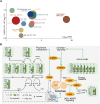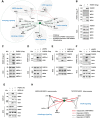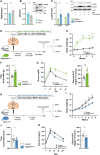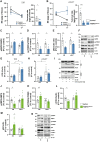Mediobasal hypothalamic FKBP51 acts as a molecular switch linking autophagy to whole-body metabolism
- PMID: 35263141
- PMCID: PMC8906734
- DOI: 10.1126/sciadv.abi4797
Mediobasal hypothalamic FKBP51 acts as a molecular switch linking autophagy to whole-body metabolism
Abstract
The mediobasal hypothalamus (MBH) is the central region in the physiological response to metabolic stress. The FK506-binding protein 51 (FKBP51) is a major modulator of the stress response and has recently emerged as a scaffolder regulating metabolic and autophagy pathways. However, the detailed protein-protein interactions linking FKBP51 to autophagy upon metabolic challenges remain elusive. We performed mass spectrometry-based metabolomics of FKBP51 knockout (KO) cells revealing an increased amino acid and polyamine metabolism. We identified FKBP51 as a central nexus for the recruitment of the LKB1/AMPK complex to WIPI4 and TSC2 to WIPI3, thereby regulating the balance between autophagy and mTOR signaling in response to metabolic challenges. Furthermore, we demonstrated that MBH FKBP51 deletion strongly induces obesity, while its overexpression protects against high-fat diet (HFD)-induced obesity. Our study provides an important novel regulatory function of MBH FKBP51 within the stress-adapted autophagy response to metabolic challenges.
Figures






Similar articles
-
FKBP5/FKBP51 on weight watch: central FKBP5 links regulatory WIPI protein networks to autophagy and metabolic control.Autophagy. 2022 Nov;18(11):2756-2758. doi: 10.1080/15548627.2022.2063006. Epub 2022 Apr 19. Autophagy. 2022. PMID: 35438043 Free PMC article.
-
Contribution of the co-chaperone FKBP51 in the ventromedial hypothalamus to metabolic homeostasis in male and female mice.Mol Metab. 2022 Nov;65:101579. doi: 10.1016/j.molmet.2022.101579. Epub 2022 Aug 23. Mol Metab. 2022. PMID: 36007872 Free PMC article.
-
Hypothalamic Fkbp51 is induced by fasting, and elevated hypothalamic expression promotes obese phenotypes.Am J Physiol Endocrinol Metab. 2012 Apr 15;302(8):E987-91. doi: 10.1152/ajpendo.00474.2011. Epub 2012 Feb 7. Am J Physiol Endocrinol Metab. 2012. PMID: 22318949 Free PMC article.
-
Focus on FKBP51: A molecular link between stress and metabolic disorders.Mol Metab. 2019 Nov;29:170-181. doi: 10.1016/j.molmet.2019.09.003. Epub 2019 Sep 11. Mol Metab. 2019. PMID: 31668388 Free PMC article. Review.
-
FKBP51 and the molecular chaperoning of metabolism.Trends Endocrinol Metab. 2021 Nov;32(11):862-874. doi: 10.1016/j.tem.2021.08.003. Epub 2021 Sep 1. Trends Endocrinol Metab. 2021. PMID: 34481731 Free PMC article. Review.
Cited by
-
New insights into tuberous sclerosis complex: from structure to pathogenesis.Front Cell Dev Biol. 2025 Jun 27;13:1595867. doi: 10.3389/fcell.2025.1595867. eCollection 2025. Front Cell Dev Biol. 2025. PMID: 40655946 Free PMC article. Review.
-
Effects of defined voluntary running distances coupled with high-fat diet consumption on the skeletal muscle transcriptome of male mice.Physiol Rep. 2025 Jan;13(2):e70170. doi: 10.14814/phy2.70170. Physiol Rep. 2025. PMID: 39821584 Free PMC article.
-
FKBP51-Hsp90 Interaction-Deficient Mice Exhibit Altered Endocrine Stress Response and Sex Differences Under High-Fat Diet.Mol Neurobiol. 2024 Mar;61(3):1479-1494. doi: 10.1007/s12035-023-03627-x. Epub 2023 Sep 19. Mol Neurobiol. 2024. PMID: 37726498 Free PMC article.
-
FKBP51 overexpression in the corticolimbic system stabilizes circadian rhythms.Cell Stress Chaperones. 2025 Feb;30(1):22-32. doi: 10.1016/j.cstres.2024.12.003. Epub 2024 Dec 12. Cell Stress Chaperones. 2025. PMID: 39674313 Free PMC article.
-
FKBP5/FKBP51 on weight watch: central FKBP5 links regulatory WIPI protein networks to autophagy and metabolic control.Autophagy. 2022 Nov;18(11):2756-2758. doi: 10.1080/15548627.2022.2063006. Epub 2022 Apr 19. Autophagy. 2022. PMID: 35438043 Free PMC article.
References
-
- Zhang Y., Sowers J. R., Ren J., Targeting autophagy in obesity: From pathophysiology to management. Nat. Rev. Endocrinol. 14, 356–376 (2018). - PubMed
Publication types
MeSH terms
Substances
LinkOut - more resources
Full Text Sources
Molecular Biology Databases
Research Materials
Miscellaneous

